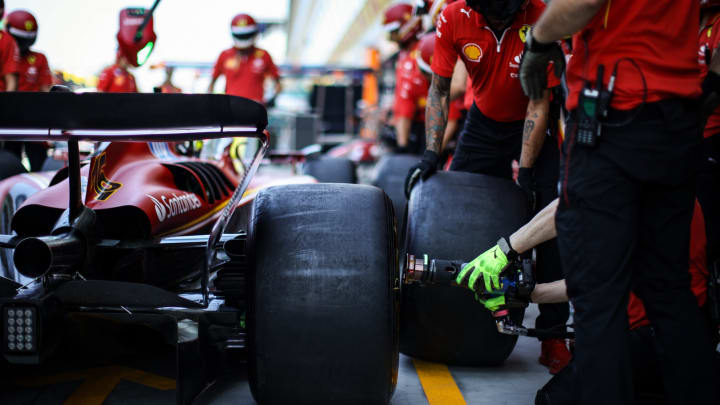Italian GP Upgrades: Ferrari Brings Serious Upgrades To Temple Of Speed

As the Formula 1 season powers into the second half of the season, the iconic Monza circuit plays host to the 2024 Italian Grand Prix. Known for its high-speed straights and demanding corners, Monza is a track where aerodynamic efficiency and drag reduction are paramount. Teams have brought a variety of upgrades specifically tailored to the unique demands of this circuit. This article provides a comprehensive overview of the changes introduced by each team ahead of the race, showcasing their strategic approaches to achieving maximum performance.
Let's look into them:
Red Bull Racing
Red Bull Racing, consistent in their pursuit of performance gains, has introduced updates aimed at refining their car’s aerodynamic efficiency after they've struggled over the last few races:
- Front Wing: The chord of the last element of the front wing has been reduced. This change is designed to achieve a specific aerobalance target by trimming the second flap element, which in turn reduces lift at higher speeds.
- Rear Wing: Similarly, the rear wing's flap chord has been trimmed to decrease the aerodynamic drag. This reduction in drag is critical for maximizing top speed at a track like Monza.
Mercedes-AMG Petronas F1 Team
Mercedes has implemented subtle yet significant changes to their rear wing assembly, focusing on drag reduction:
- Rear Wing (Tip Detail): The flap tip has been backed off, and the camber reduced. This adjustment drops local downforce and drag, which is ideal for a high lift-to-drag (L/D) ratio track like Monza.
- Rear Wing (Chord Reduction): The chord and camber have been reduced further, continuing the theme of minimizing drag while maintaining necessary downforce levels for the race.
Scuderia Ferrari
Scuderia Ferrari, racing on home soil, has brought a suite of updates aimed at both balance and flow conditioning:
- Front Wing: A new lower downforce front wing flap design has been introduced, with various trims available to allow modulation based on the circuit's demands.
- Nose: The position of the nose camera has been optimized to improve the interaction between the front wing upwash and the front suspension legs, enhancing flow quality downstream.
- Mirror Stays: Ferrari has shortened the mirror stays to improve the aerodynamic flow towards the rear of the car.
- Floor Components: Several components, including the floor fences, floor body, floor edge, and diffuser, have been reshaped or redesigned to improve flow conditioning and local load generation. These changes aim to optimize the car’s aerodynamics, especially in the underbody and diffuser regions, which are critical for maintaining stability and downforce.
- Coke/Engine Cover and Rear Wing: The Coke/Engine cover features a deeper undercut, and the rear wing has been redesigned with lower downforce profiles suitable for Monza’s high-speed sections.
McLaren Formula 1 Team
McLaren has introduced several updates targeting both aerodynamic balance and brake cooling:
- Front Corner: A revised front brake duct geometry increases brake cooling performance, crucial for a track with high-speed braking zones, while maintaining aerodynamic efficiency.
- Front Wing: A new front wing flap design extends the available aerobalance range, offering flexibility in managing the car's behavior across different sections of the track.
- Coke/Engine Cover: The sidepod shape has been modified to improve flow conditioning, particularly beneficial for the rear aerodynamic performance.
Aston Martin Aramco F1 Team
Aston Martin has made updates to both the front and rear wing assemblies, aiming to fine-tune their car's balance:
- Front Wing: A new flap with reduced incidence decreases the load on the wing, which helps in balancing the car when using a lower-loaded rear wing.
- Beam Wing and Rear Wing: A smaller beam wing with a short chord second element and a less aggressive upper rear wing cascade have been introduced. These changes reduce both load and drag, aligning with the demands of Monza's high-speed layout.
BWT Alpine F1 Team
Alpine has made targeted adjustments to their front wing, focusing on balance:
- Front Wing: The front wing flap has been reprofiled to accommodate the required balance range when running lower rear wing levels, typical for Monza.
Williams Racing
Williams has introduced updates to both their front and rear wings, with a focus on drag reduction and aerodynamic balance:
- Front Wing Endplate: Part of the trailing edge of the front wing endplate has been removed, and the dive plane reoriented. This reduces drag and improves the efficiency of the flow structures.
- Front Wing (Flap): A smaller, reprofiled rearward flap reduces local load, helping to balance the small rear wings used at Monza.
- Rear Wing: An optional trim reduces the chord length of the rear wing flap, providing flexibility in managing the balance between downforce and drag.
Visa Cash App RB
Visa Cash App RB has made several refinements across multiple components, focusing on balance and flow conditioning:
- Front Wing: A shorter chord flap reduces the overall load generated by the front wing, aligning with the low-drag rear wings used at Monza.
- Floor Body and Rear Wing: Profile changes to the main underfloor increase local downforce generation, while the rear wing’s reduced camber and chord help achieve the lower drag levels needed.
- Beam Wing and Halo: The beam wing’s chord reduction and the refined shape of the Halo fairing contribute to managing drag and improving flow conditioning downstream.
- Mirrors: Simplified geometry around the mirrors reduces drag, enhancing the car’s efficiency for the Monza circuit.
Stake F1 Team KICK Sauber
Sauber has introduced several updates, aiming to optimize their car’s aerodynamic performance:
- Front Wing: A low-balance front wing flap design reduces the load to rebalance the low-drag rear wing introduced for this event.
- Floor Body and Diffuser: The forward floor body has been redesigned to increase local load while maintaining clean flow, and a small change to the diffuser sidewall design helps increase high-energy flow into the diffuser.
- Rear Wing: A new low-drag rear wing assembly reduces load efficiently, with options to tune load and drag further.
MoneyGram Haas F1 Team
Haas has brought updates to both the front wing and suspension, focusing on balance and flow conditioning:
- Front Wing: A low camber front wing flap design complements the low-drag rear wing introduced in Spa, maintaining balance.
- Front Suspension: The re-profiled lower wishbone and pushrod fairing complete the front suspension update, optimizing compliance with the incoming flow.
The 2024 Italian Grand Prix at Monza sees teams employing a range of aerodynamic and cooling updates specifically tailored to the circuit’s unique demands. Red Bull, Mercedes, Ferrari, McLaren, and other teams have focused on reducing drag while maintaining or improving aerodynamic balance.
